The TEAC UD-507 is a completely redesigned 500 series DAC/preamp/headphone amplifier that TEAC says incorporates trickle-down technology from their reference TEAC 701 series design concept, but in a more compact two-thirds form factor. Given its smaller size, many music enthusiasts’ first thought might be to use the TEAC UD-507 as a desktop headphone amplifier. There’s nothing wrong with that, but that wouldn’t be taking full advantage of all the UD-507 has to offer. As I found out, where the TEAC UD-507’s value really comes to the forefront is when it’s enlisted as the centerpiece of a proper two-channel system with its stellar DAC and preamplifier abilities, in addition to its capability as a high-end headphone amplifier.
For those unfamiliar with TEAC, the audio company was founded in 1953. The Japanese outfit became one of the most lauded manufacturers of high-end audio equipment in the 1970s and 1980s. They were particularly favored for their reel-to-reel tape machines, as well as cassette decks, back in the day. They also produced audiophile turntables, CD players and power amplifiers. Today, the corporation is made up of four divisions, two of which include Esoteric, a producer of ultra-high-end audiophile products, and TEAC Consumer Electronics, which produces mass market audiophile products such as the UD-507, the subject of this review.
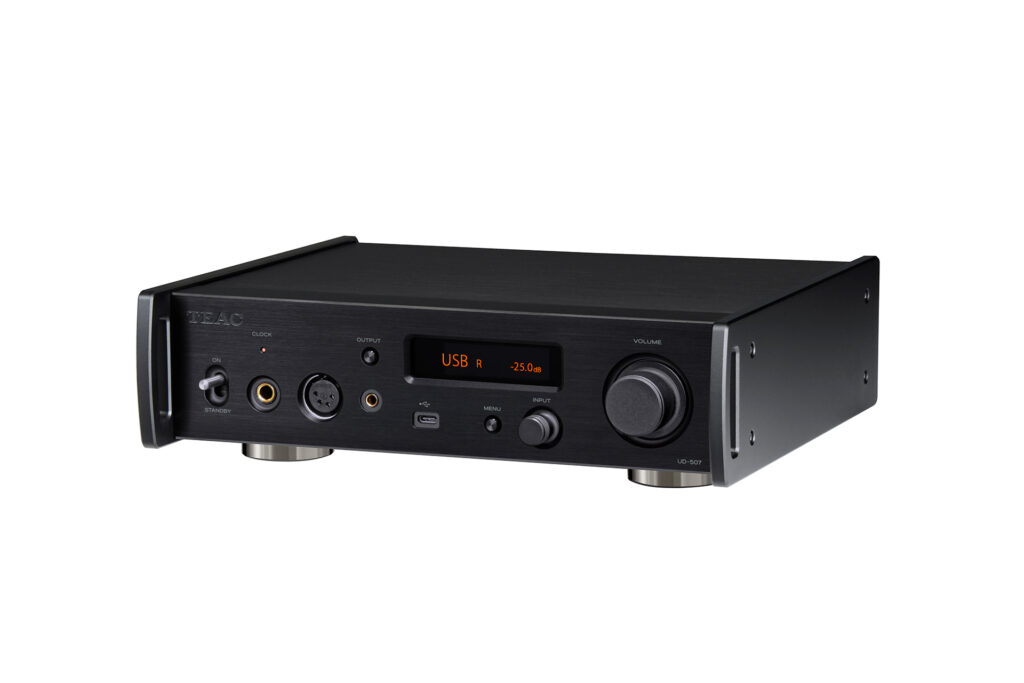
What Makes the TEAC UD-507 DAC/Preamp/Headphone Amplifier So Special?
- On well-made recordings, the TEAC UD-507 delivers an expansive soundstage with precise imaging, highly-defined transients and terrific bass dynamics. That’s rare to find at these price points.
- The TEAC UD-507 employs a dual mono structure throughout the unit, from the power circuit with independent left and right toroidal core transformers to the D/A converter section and the output stage, eliminating crosstalk or interference between channels and improving the signal to noise ratio and dynamic range.
- The TEAC UD-507 also features a fully balanced, dual monaural headphone amplifier. TEAC has implemented TEAC-HCLD2 (an enhanced version of their high-current line driver) output buffer circuits to increase the current transfer capabilities of the UD-507’s integrated amplifier and preamplifier. Each channel has a positive and negative dual circuit structure, with high-current diamond buffer amplifiers being used as line drivers. By increasing the current handling capability, balanced or high-impedance headphones can be used. By strengthening the power supply, UD-507’s maximum output power is significantly improved compared to its predecessor, the UD-505-X.
- Rather than take the typical route of opting for a generic DAC IC (integrated circuit), TEAC opted for an in-house proprietary design discrete DAC they refer to as “TRDD 5” (TEAC Reference Discrete DAC) in the UD-507. This discrete DAC represents a similar signal conversion strategy to their flagship UD-701N DAC/Network Player. This approach, while more expensive, enables the designer much greater flexibility in their design to achieve their desired sound output characteristics and feature set. The TRDD 5 DAC incorporates a proprietary algorithm, using an FPGA (Field-Programmable Gate Array) in front of the DAC to process all digital signals input into the UD-507 and then converts them to analog signals in the discrete DAC. The DSD signal is processed as is, while the PCM signal is transmitted after passing through the delta-sigma modulator on the FPGA and is converted to either a PCM multi-bit or a DSD 1-bit signal, selectable by the user.
- The discrete DAC has a separate power supply from that for the FPGA, eliminating any concern about noise from the digital processing upsetting the analog section. That enables a simpler design for the analog section. For example, simpler noise filtering and a simpler output buffer design have been employed in the TEAC UD-507 as a result.
- A set of three selectable filters can be applied to DSD signals (either native or converted from PCM) to subtly shape the sound to the user’s preference. While I ultimately left the filters (EQ) off for critical listening, some listeners will find the feature beneficial for their particular setups and listening environments. And, in my opinion, it’s always nice to have options.
- The D/A converter section is independent of the left and right channels, thereby preventing interference between left and right signals, which likely was a contributor to music being reproduced with such precise imaging within the airy and three-dimensional soundstage that I experienced while listening.
- The excellent interpolation filter employed in the TEAC UD-507 results in outstanding transient reconstruction accuracy, providing a more lifelike soundstage. Transients are the queues our brain uses to decipher where instruments are located within the soundstage, to separate individual instruments within that space, to recognize the timbre of instruments, and to identify the starting and stopping of notes.
- With the TEAC TRRD 5 discrete DAC, USB playback of up to DSD 22.5 MHz and PCM 32-bit/384 kHz signals is possible.
- Via the USB digital audio input, upconversion options of the input sampling frequency are selectable from the remote control to apply upsampling rates of 2x, 4x, 8x, or no upconversion (off). I recognize that whether there are benefits from upsampling or not is an endlessly debated topic in the audiophile community, but that’s not the point here. The point is, even if you choose not to apply upsampling (you can always leave it off), it’s nice that TEAC included the option. I suspect it will be appreciated by many enthusiasts.
- The TEAC UD-507 has an array of input options, including five digital inputs (USB Type-B rear, USB Type-C front, optical, coaxial, and Bluetooth 4.2) and two analog inputs (XLR and RCA). There are also both XLR balanced and RCA unbalanced outputs available.
- The TEAC UD-507 incorporates a full-stage, dual monaural/balanced circuit configuration throughout from its power circuit, with independent left and right toroidal core transformers to its D/A converter section and through the analog output stage. This approach ensures complete channel separation with no interference or crosstalk.
- The TEAC UD-507 features multipoint Bluetooth connectivity, allowing the user to connect two Bluetooth devices simultaneously. This feature enables quick switching between devices for output audio quality comparison purposes.
- The headphone amplifier gain can be switched between three positions (low/mid/high) to fine-tune the output to best match the sensitivity and impedance of the specific headphones used, with support for high-impedance headphones of up to 600 ohms. Also, there are three connection options to accommodate a variety of headphones, including a 6.3mm (one-quarter-inch) TRS stereo jack, a 4.4mm five-pole Pentaconn jack, and a XLR four-pin jack.
- The TEAC UD-507 provides a BNC input connector to enable the connection of an external clock generator, such as the TEAC CG-10M-X Master Clock Generator to deliver an extremely accurate 10 MHz clock signal. While not necessary, it’s nice to know there is a future upgrade path for those interested.
- The UD-507 incorporates the TEAC-QVCS high-precision analog volume attenuator. The line out level can be set to variable and then adjusted, using the volume knob or remote control to change level in single increments from zero to 100.
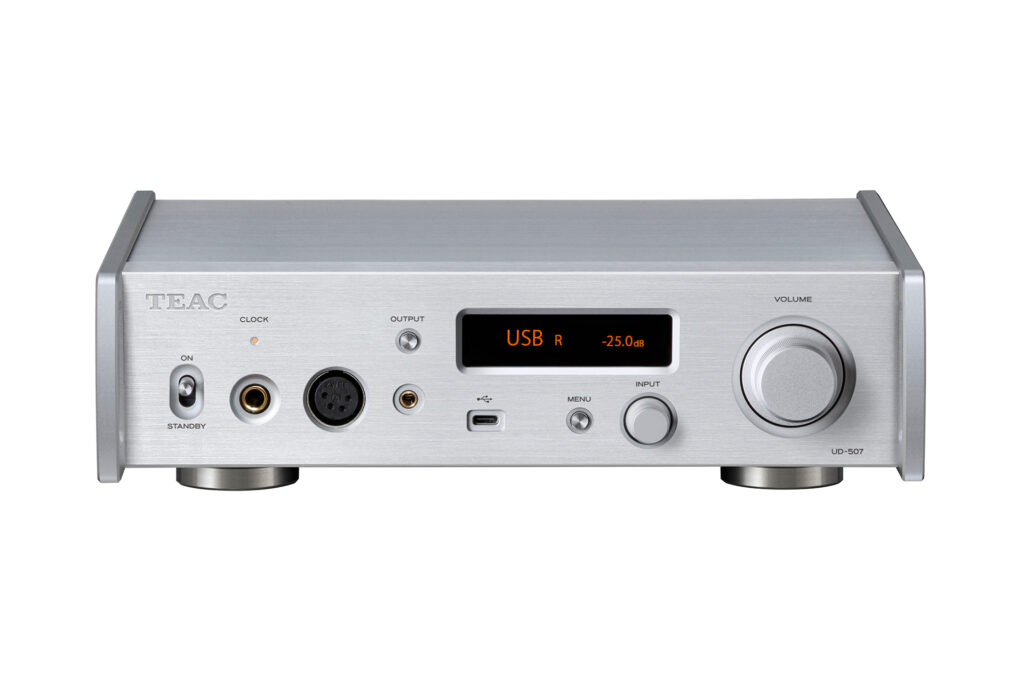
Why Should You Care About the Teac UD-507 DAC/Preamp/Headphone Amplifier?
Most DACs utilize an off-the-shelf DAC chip from companies like ESS Technologies, AKM Semiconductor or Texas Instruments. TEAC takes a different approach with their UD-507, incorporating an FPGA along with their own proprietary discrete DAC IC design and software. This approach provides many benefits, including the ability to tailor the sound output signature and feature set to TEAC’s preference. The result of the unique set of technologies built into the TEAC UD-507 is the ability to deliver an expansive soundstage with precise imaging, highly-defined transients and terrific bass dynamics. In addition, the UD-507 has a reference-level, high-power headphone amplifier built in, with multiple power and connection options available, so that almost any headphone can be utilized. Headphones with impedance ratings up to 600 ohms can be easily driven. The industrial-looking TEAC UD-507 exudes quality with its thick aluminum faceplate and evident solid construction. The UD-507 is loaded with connection options, too. The connected gear and multiple settings available are all selectable from the faceplate or the well-designed remote control.
Some Things You Might Not Like About the Teac UD-507 DAC/Preamp/Headphone Amplifier
- It’s hard to find much to dislike about the TEAC UD-507, even after several months of use. If I was to nitpick, I would like to see a subwoofer output included to provide the option to run a 2.1 configuration for those who need or prefer to add a sub to their setup rather than run a straight two-channel configuration. Of course, I imagine that would increase the price of the unit.
- While having no impact on performance, my personal preference would be to have a larger faceplate display for easier viewing across the room. While the text for the input type and volume is large enough, the text for the file type and resolution are smaller and was difficult to read legibly from my listening position.
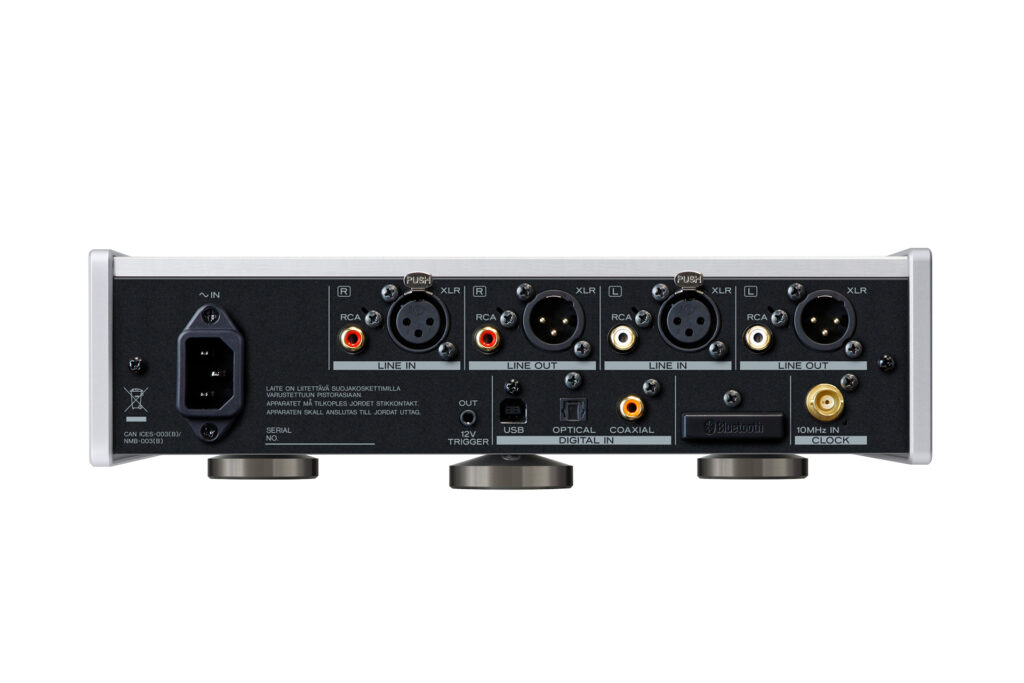
Listening to the TEAC UD-507 DAC/Preamp/Headphone Amplifier …
For my listening sessions, sources to the TEAC UD-507 included a Mac Mini dedicated music server, using Roon software (learn more here) and an Esoteric CD/SACD player. I used both my reference Aerial Acoustics 7T floorstanding speakers and the Alta Audio Alyssa (read the review) stand-mount speakers I still had in my house for review. Power was provided by a Classé amplifier. I listened to several tracks to determine the TEAC UD-507’s ability to recreate a believable soundstage with dimension and space. On Sting’s “Shape of My Heart” from his Ten Summoner’s Tales album (CD, A&M), the transient attack and decay of the instruments was realistically reproduced, including that iconic guitar riff written and played by Dominic Miller. The striking of the edge of the snare with the drumstick had a very distinct snap to it, with a well-defined beginning and end. The drumkit clearly appeared further back in the soundstage from the other instruments, providing depth to the soundstage. There was obvious space between individual instruments and vocals. The soundstage recreated by the UD-507 indicated a somewhat intimate recording space, where the width was equal to that of the speakers in my room. The high notes of the harmonica and flute appearing at the 3:40 mark were also reproduced with great accuracy, with the flute’s high C sounding bright and airy as it should, not harsh or sibilant. The overall presentation was so realistic that I could have been sitting in the recording studio listening with the musicians.
Moving on to evaluate the TEAC UD-507’s ability to recreate a larger recording space, I listened to the track “Promise” by Dutch band HAEVN from their album Wide Awake (Qobuz, Hi-Res, Nettwerk Music Group). Transient decay of the piano, acoustic guitars and cello was drawn out, indicating a very large space. The UD-507 again was very good at recreating bass dynamics, with the low notes played on the drums and synthesizer having appropriate weight and impact. When backup vocalists joined lead singer Marijn van der Meer’s vocal for the chorus (at 2:08 minute mark), I was hit with a wall of lush, enveloping reverberant sound that literally extended from wall to wall. Like previous tracks, instruments were again well-defined within the large space, with the expansive soundstage having discernible depth as well as width.
To explore the TEAC UD-507’s ability to deliver low-end dynamics, I listened to bass torture test tracks from Michael Jackson, Billie Eilish, and The Weeknd. Playing the bass-heavy track “Starboy” from The Weeknd’s (aka: Abel Tesfaye) album by the same name and accompanied by Daft Punk (Qobuz, Hi-Res, Universal Republic Records), the UD-507 created a very coherent and stable soundstage with chest-thumping bass throughout. Vocals and instruments were well-defined within that space throughout the track. This bass torture test track has a lot going on and I’ve heard it sound a bit muddled on less capable DACs. With the track’s increased clarity when played through the UD-507, I found myself hearing additional details and turning up the volume louder than normal to fully immerse myself within all that pulsating bass.
Will the TEAC UD-507 DAC/Preamp/Headphone Amplifier Hold Its Value?
While most DACs utilize an off-the-shelf DAC IC with no possibility of updating features or improving performance, the fact that the TEAC UD-507 utilizes an FPGA with a discrete DAC means that downloadable firmware updates are possible to implement future changes. For example, TEAC has put out a firmware update to its flagship UD-701N DAC/Network Player since its introduction. The possibility of making future changes, combined with TEAC’s long-standing brand reputation, should extend the UD-507’s relevance, thereby enhancing its resale value, versus similarly-priced DACs utilizing an off-the-shelf DAC IC.
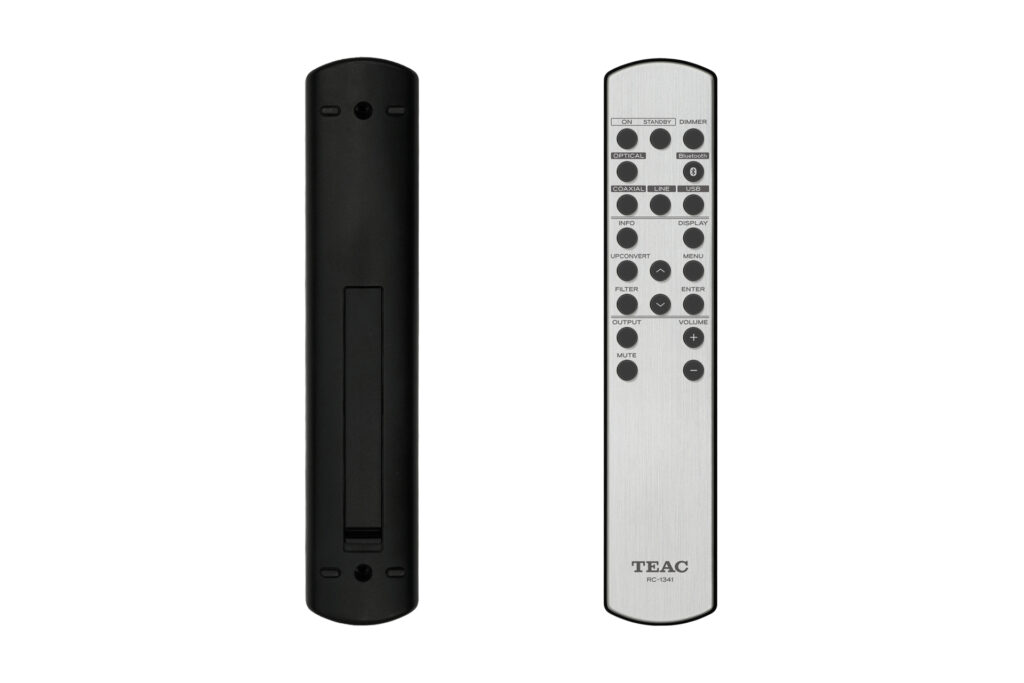
What is the Competition for the TEAC UD-507 DAC/Preamp/Headphone Amplifier?
The Benchmark DAC3 HGC DAC ($2,399 – read the review) is another DAC/preamp/headphone amplifier option available in a similar compact form factor to the TEAC UD-507. Digital inputs for the DAC3 HGC include one PC-USB, two coaxial capable of receiving up to 24-bit/192 kHz PCM or DSD (DoP 1.1 format) and two optical capable of up to 24-bit/96 kHz PCM. Analog inputs include two pairs of RCA unbalanced connections. Analog outputs include one pair of XLR balanced connectors and two pairs of RCA unbalanced connectors. On the front panel, there are two one-quarter-inch (6.3mm) headphone jacks served by a high-gain headphone amplifier more than capable of serving two different pairs of power-hungry headphones simultaneously.
Another compact form factor competitor to the TEAC UD-507 is the Chord Electronics Hugo 2 DAC/Headphone Amplifier ($2,175). Although primarily intended for mobile or desktop use, the Chord Hugo 2 sports RCA analog out jacks (but no XLR balanced out jacks) for integration into a full-size two-channel system. Like the TEAC UD-507, the Chord Hugo 2 has a similar FPGA, plus discrete DAC design. It also has three selectable filters to tailor the sound output to your preference, much like the TEAC UD-507. With the ability to also serve as a preamplifier, volume can either be set to fixed or adjustable via top-mounted controls or the included remote control. Digital inputs include an optical, a digital coaxial, and a micro-USB, as well as a Bluetooth wireless connection. For headphone use, there’s both a 3.5mm and 0.25-inch jack available. The USB input is capable of receiving up to DSD512 or PCM up to 769 kHz, which more than covers every music file resolution currently available.
The NAD C-658 BluOS Streaming DAC/Preamp ($2,299 – buy at Crutchfield) is a full-size component that has a dedicated headphone amp, but with a one-quarter-inch (6.3mm) output as its only headphone connection option. Digital inputs include two optical and two coaxial, as well as PC-USB, Ethernet, WiFi 5 and Bluetooth aptX HD (one each). It also has USB Type B and Ethernet inputs (one each). However, the NAD C-658 lacks the USB-C input option found on the TEAC UD-507. The NAD C-659 has both XLR balanced and RCA unbalanced outputs (one each). NAD added a built-in MM phonostage and phono output to the C-658, something not found on the TEAC UD-507. So, with the TEAC UD-507, turntable users will also need an external phonostage for playback. The NAD C-658 also includes two subwoofer outputs for those wanting to run either a 2.1 or 2.2 speaker setup. The NAD C-658 supports native PCM sampling rates up to 32bit/192 kHz, as well as converted DSD playback via the BluOS desktop app. The NAD C-658 employs the ESS Sabre 32-bit DAC chip for decoding.
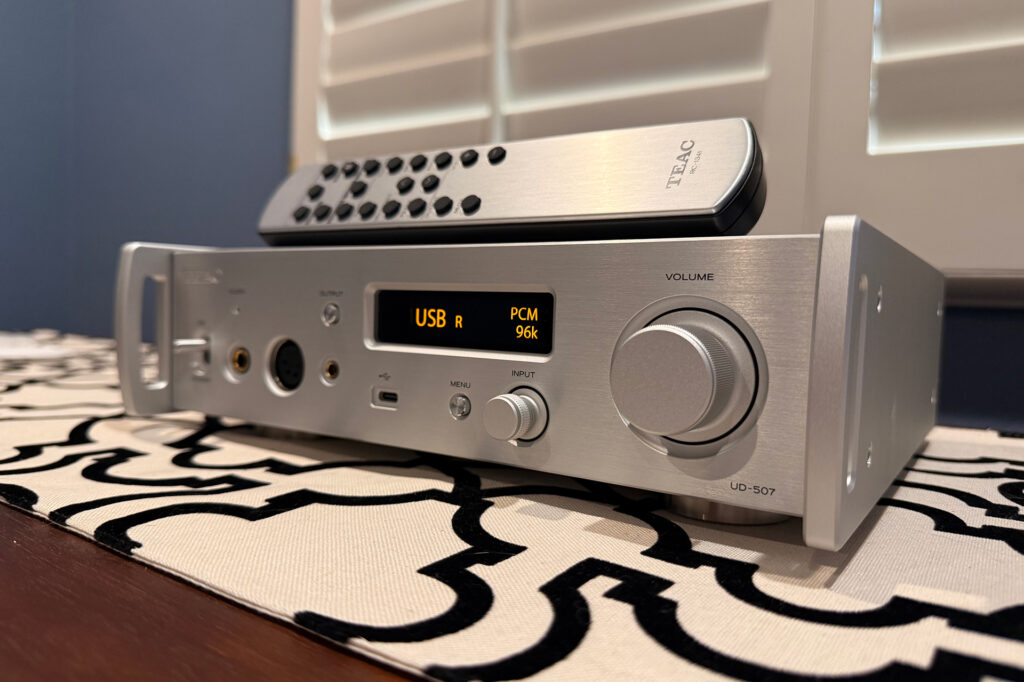
Final Thoughts on the Teac UD-507 DAC/Preamp/Headphone Amplifier …
The footprint of the dual monoaural design Teac UD-507 may not be mighty in size, but it’s certainly mighty in technology, features and performance, making it an excellent choice to serve as the hub of a mid-priced, high-end, two-channel system. In addition, it packs in a reference level, fully-balanced high-power headphone amplifier to boot. Combining all its features into one package makes the TEAC UD-507 a very good value for the price and a more than worthy contender among its competition.




No HDMI input limits it’s capabilities for high res.
Definitely lack of dedicated subwoofer output terminals is a minus point. I payed advance for UD 507, AP 507 and CG10MX Clock at Absolute Sound, Singapore. I will be travelling to Singapore in the month of October to pick them.